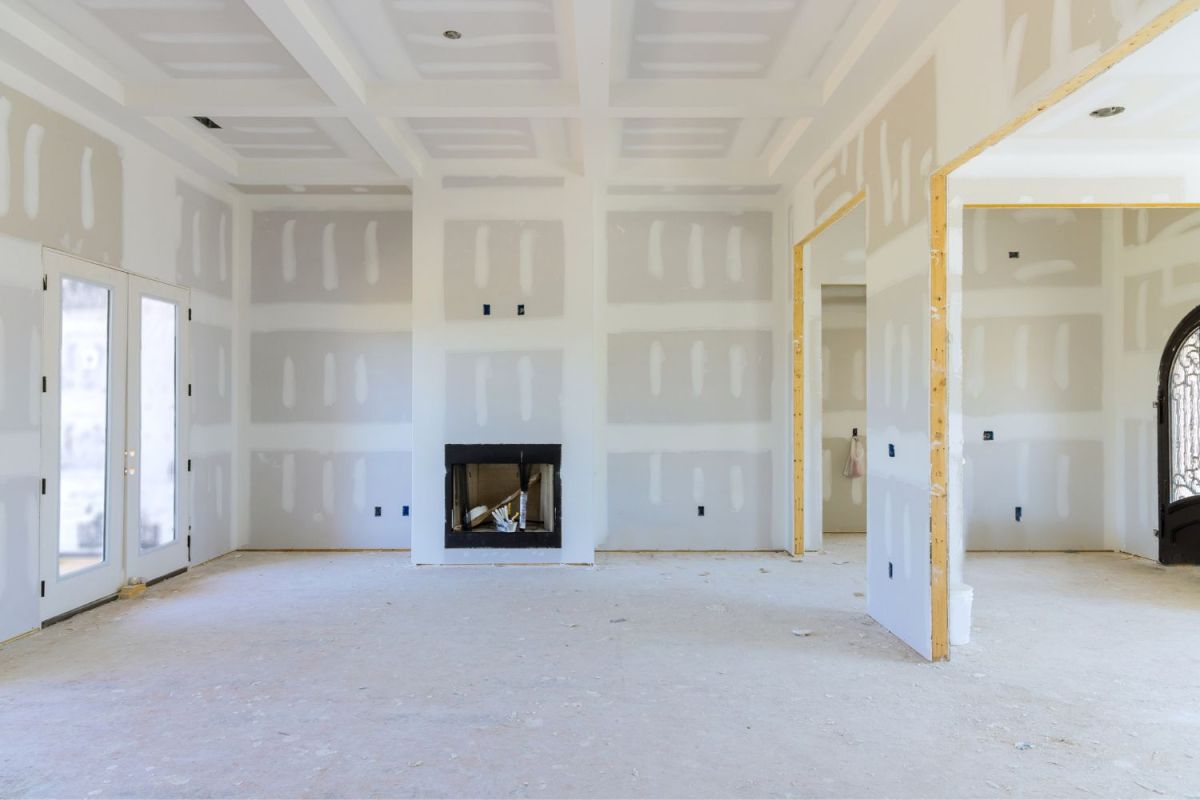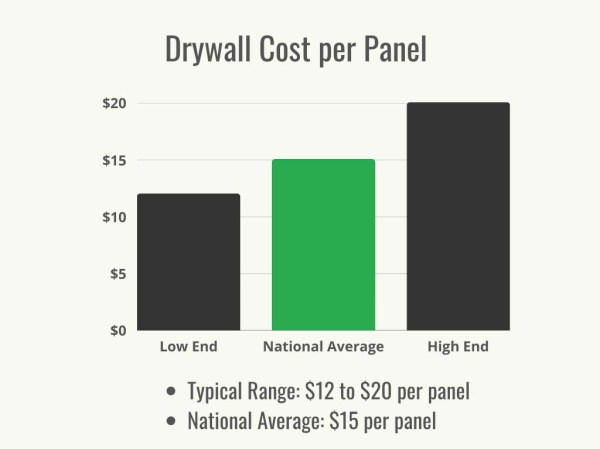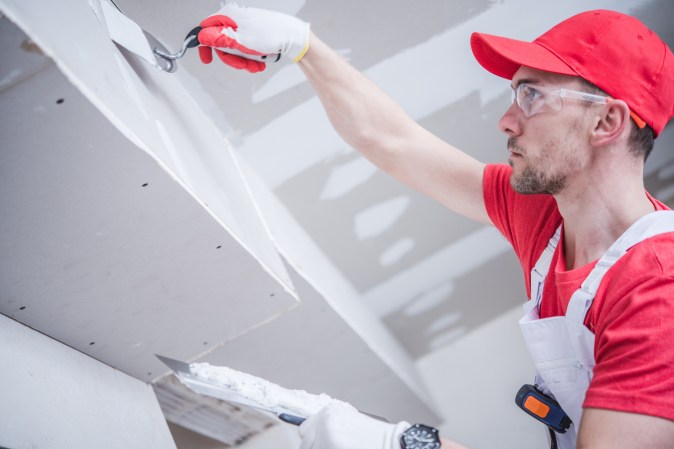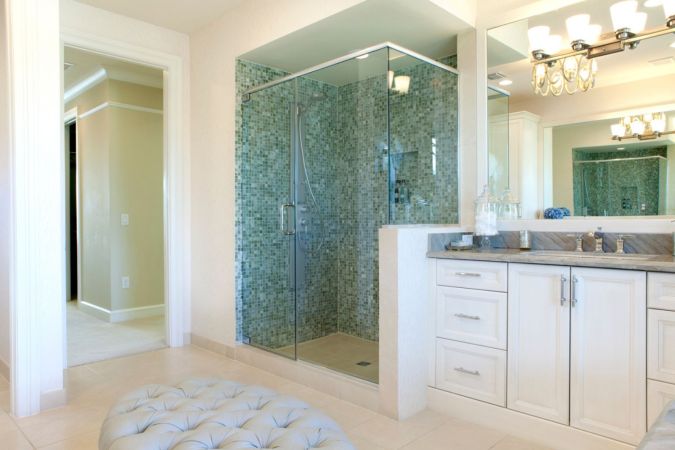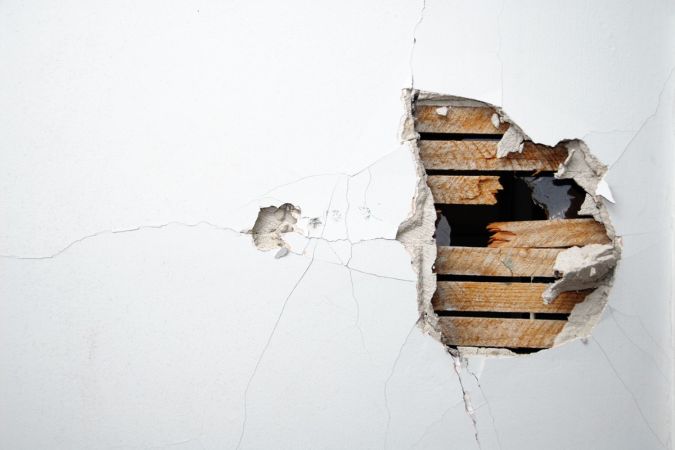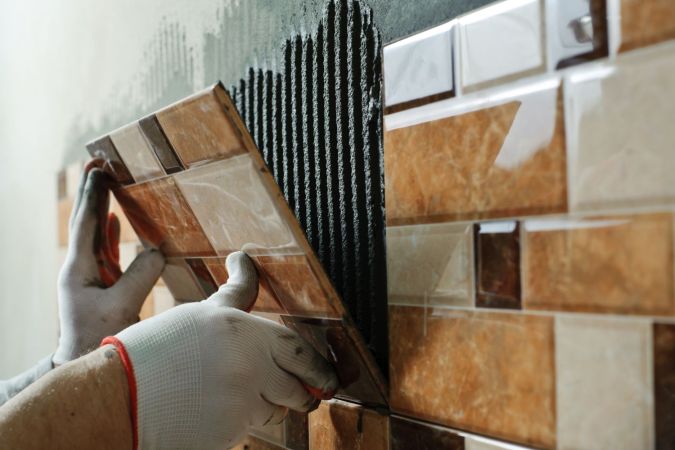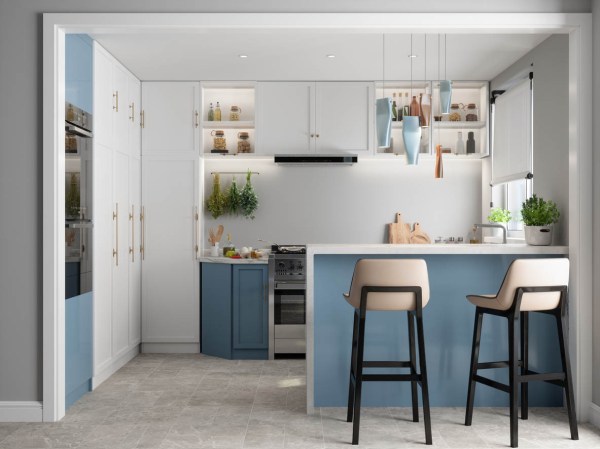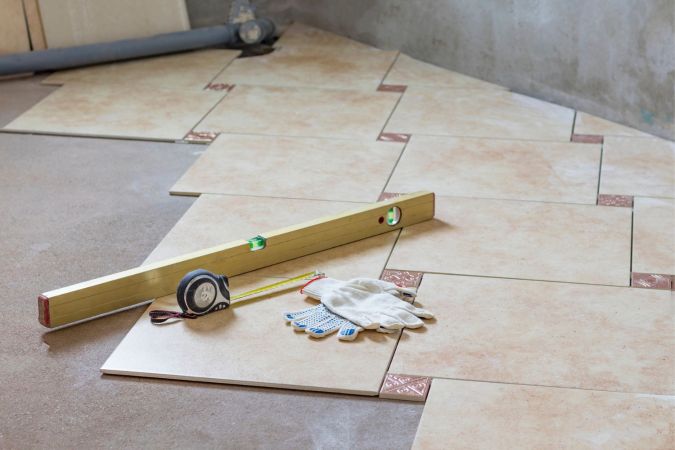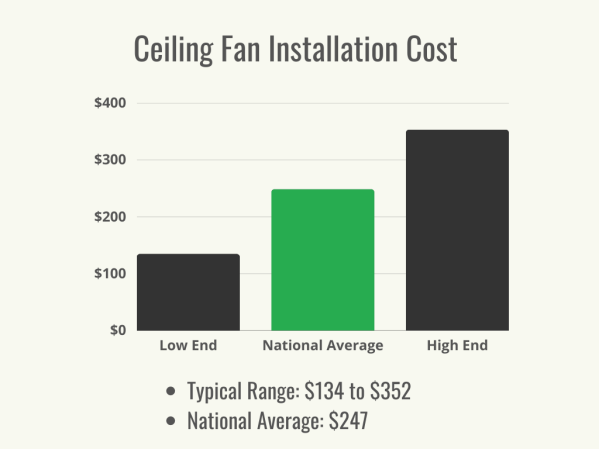We may earn revenue from the products available on this page and participate in affiliate programs. Learn More ›
Highlights
- Sheetrock typically costs between $12 and $20 per panel, and the national average is $15 per panel.
- The exact cost of sheetrock depends on factors such as home size, panel size, panel thickness, sheetrock type, installation method, location within the home, and finishing.
- Sheetrock offers many benefits, including affordability; durability; resistance to fire, mold, and mildew; numerous customization options; quick installation; and easy maintenance and repairs.
- A handy homeowner may have the skills required to hang panels of drywall or sheetrock, but it’s often easier to leave the job to a professional who has experience with this project and can ensure the installation is completed safely and to code.
Whether it’s a living room revamp, a bathroom rebuild, or a bedroom remodel, sheetrock plays an important role when it comes to transforming living spaces. Also known as drywall, sheetrock is the main building component of interior walls and ceilings. It provides a smooth and even surface that can be finished with paint, wallpaper, or custom textures. Interior spaces often look incomplete or exposed before sheetrock is hung.
It’s not just about looks, though. Sheetrock also helps insulate against sounds and temperature changes while contributing to the overall structure of a home. Without sheetrock, a house remains a bare shell. For such a fundamental component in construction, sheetrock is budget-friendly. According to Angi and HomeAdvisor, the national average sheetrock cost per panel is $15, falling within a typical range of $12 to $20. This guide explores some of the most common factors in determining sheetrock costs, tips on saving money on installation, and questions to ask a drywall contractor before starting a project.

Factors in Calculating Sheetrock Cost
As with costs in any home construction project, sheetrock costs can be influenced by various factors. The following are some of the most important factors to consider when homeowners are determining costs for a sheetrock project, though it’s important to keep in mind that national averages may not always align with local costs.
Home Size
While there are other factors to consider, home size is one of the most important to remember when homeowners are estimating sheetrock costs. The larger the home, the more square footage of drywall is required to finish the job. This directly impacts material costs.
Bigger homes often have more intricate layouts and custom features, such as archways and alcoves. Additional cutting, fitting, and finishing can increase labor costs. Tall ceilings are common in larger homes and can also boost material and labor costs. Additional rooms in a larger home can contribute to higher overall pricing as well.
Homes with the same flooring square footage might vary significantly in wall and ceiling square footage. However, installing drywall in a standard 12-foot by 12-foot room can cost anywhere from $1,000 to $1,600.
Panel Size
When budgeting for drywall costs, homeowners will find that panel size is a major influencing factor. Sheetrock panels come in various sizes; generally, larger panels cost more than smaller sheetrock sizes. There are several reasons for this cost difference.
To start, larger panels require more material, increasing production costs. Drywall contractors may charge more in labor for large panels, as they require more time and effort to maneuver safely. There’s also the potential for more waste with large panels if they need to be cut down drastically to meet the layout needs of a space. Some sizes may be difficult to track down, affecting pricing. The following table shows some of the most popular sizes and their price ranges.
| Panel Size in Feet | Average Cost per Panel (Material Only) |
| 4 by 8 | $10 to $15 |
| 4 by 9 | $10 to $17 |
| 4 by 10 | $10 to $20 |
| 4 by 12 | $15 to $27 |
| 4 by 16 | $16 to $35 |
Panel Thickness
Just as panel size is a key factor in overall cost, panel thickness plays an important role in how much sheetrock costs. Thicker panels tend to cost more per square foot, but they may offer better insulation, reduce energy consumption, and provide energy savings. Depending on the components, thicker panels can also offer better fire resistance and soundproofing. All of these benefits can make the additional costs worth considering.
Choosing thinner sheetrock panels can be more cost-effective initially, though. Thinner panels are lighter and require less labor. They’re also more versatile and can be used in tighter spaces where thicker panels can be difficult to work with. Homeowners can keep the following cost ranges in mind when considering sheetrock panel thickness.
| Drywall Thickness | Average Cost per Panel (Material Only) |
| ¼ inch | $10 to $12 |
| ⅜ inch | $10 to $15 |
| ½ inch | $10 to $20 |
| ⅝ inch | $13 to $75 |
Sheetrock Type
Homeowners have multiple sheetrock types to consider when revamping interior walls and ceilings. Each type has unique features and advantages along with distinctive price ranges. For example, standard drywall tends to be the most budget-friendly option. It’s an economical choice for many projects but does have limitations when it comes to advanced features.
Sheetrock types such as blue board and abuse-resistant have a higher price than standard drywall but offer specific benefits. For example, abuse-resistant drywall is less likely to develop dings or dents. Homeowners are often willing to pay extra for sheetrock panels that protect their investment.
The most expensive types of sheetrock, such as Type X and soundproof options, offer the most comprehensive benefits. They can help slow down the spread of a fire, resist mold and mildew growth, and reduce sound transmission much better than standard sheetrock types.
Installation Location
Drywall costs can also vary within a home based on location. For example, small bathroom installations can cost more per square foot, since they require more costly moisture-resistant drywall panels. Larger areas, such as basements and garages, can cost less per square foot, as installation is often simpler and requires a lower finishing level, reducing labor costs.
Also, hanging sheetrock in an entire home can cost less per square foot than working in a single room. Bulk purchases and more efficient labor can help save on costs. Homeowners who want to revamp the drywall in their entire home can save by completing the whole project at one time rather than in smaller steps.
Labor
Labor can make up half of an entire drywall job’s cost. Homeowners can expect to pay anywhere from $50 to $100 per hour for labor, though the final hourly cost depends on a few variables, including project size, installation complexity, local labor rates, accessibility of the work area, skill and experience of the contractor, and specialized techniques or finishes.
Compared to the installation of other wall and ceiling options, such as plaster, drywall installation is fairly quick. Hanging drywall typically takes 1 to 2 hours, while taping and mudding can take anywhere from 2 to 4 hours. Sanding, priming, painting, and cleaning up can go quickly with an experienced team.
Finishing
Drywall finishing refers to the condition a drywall sheet is left in for final decorative treatments, including paint, wallpaper, or wainscoting. Homeowners can choose from six different levels, starting with level 0 and finishing with level 5. Since higher levels include more steps and labor, they tend to cost more.
Level 0 is the least expensive and involves simply hanging the sheetrock panels and screwing them into the studs. It’s typically a temporary finish. A level 4 finish will still require a bit of DIY from the homeowner to get it prepped for paint. Paying for level 5 typically includes primed panels and, depending on the contractor, sometimes even paint. Professional sheetrock installers determine the fine print of their company’s finishing levels, but here are some basic cost ranges for homeowners to keep in mind.
| Sheetrock Finishing Level | Average Cost per Square Foot (Materials and Labor) |
| Level 0 | $0.30 to $0.80 |
| Level 1 | $0.70 to $1.50 |
| Level 2 | $0.80 to $1.75 |
| Level 3 | $0.90 to $2.50 |
| Level 4 | $1 to $3 |
| Level 5 | $1.15 to $3.50 |
Additional Costs and Considerations
Beyond panel specifics, installation location, and local labor costs, there are other potential costs to keep in mind. Homeowners will want to factor in the following considerations to keep their timeline and budget on track.
Old Sheetrock Removal
For repair work and design updates, old sheetrock removal is an additional cost to keep in mind. Homeowners can expect to pay between $0.30 and $0.45 per square foot for removal, with the final cost dependent on a few variables.
For example, working around obstacles or additional elements such as electrical wires or plumbing can influence the pricing. A demo team needs to use extreme care around pipes and outlets, and this takes extra time and skill.
Another factor to consider is the home’s age. In older homes, the presence of lead-based paint could boost removal pricing, as dealing with hazardous materials requires specialized equipment and knowledge.
Insulation
Insulation helps to regulate indoor temperatures by providing a thermal barrier. During the summer, it helps to keep indoor temperatures cooler while helping to retain indoor heat during the winter. Insulation also helps to prevent pipes from freezing during extreme cold snaps.
Installing insulation costs anywhere from $1,050 to $2,500, depending on the size of the home and the type of insulation material used. But while there’s an initial investment to consider with insulation, it typically pays for itself over time through energy savings. Insulation can also reduce the risk of costly plumbing repairs and help increase the resale value of a home. Potential buyers often look for energy-efficient features that can reduce utility costs.
Asbestos Removal
Asbestos removal can be an unfortunate but necessary additional cost to absorb if the material is discovered during a sheetrock installation project. Asbestos is a carcinogenic material and should only be removed by professionals with the appropriate protective gear and experience.
The cost of asbestos removal from sheetrock typically ranges from $1,200 to $3,100, depending on the extent of the contamination and its location. Testing costs are not included in this range and can add another $250 to $850 to the removal price. Testing lets contractors know how bad the contamination is and which removal process is best.
Texture Application
Applying texture to drywall is a creative and functional way to boost the aesthetics and performance of walls and ceilings. However, the cost can vary depending on the texture type. For example, light textures cost around $0.50 to $1 per square foot. Examples include orange peel, knockdown, and sand swirl. Often applied using a spray technique, light textures add subtle depth yet have a uniform appearance.
Heavier textures are hand-applied and cost a bit more, ranging from $1.50 to $2 per square foot. A heavier texture creates a visually appealing pattern with a three-dimensional surface. Popcorn texture is one of the most well known examples of a heavy texture. It’s often seen in older homes but can help with sound absorption.
Sheetrock Repair
In certain cases, it may be more appropriate to repair sheetrock rather than replace it. The following are a few potential scenarios where sheetrock repairmay be the better option:
- There is minor damage, such as holes, dents, scratches, or small water stains.
- Budget constraints make replacement out of financial reach.
- Limited timelines warrant a quick fix over demo and installation.
- Original textures and appearances need to be preserved, especially in historic homes.
Sheetrock repair costs typically range from $80 to $225, making it the most cost-effective option when compared to replacement costs. It’s also the more environmentally friendly solution and a practical choice when there are budget and time constraints.
Painting or Wallpapering
Once sheetrock is in place, it usually still needs a little dressing up. Common options include paint and wallpaper. Painting a room costs anywhere from $150 to $1,100, depending on the size of the room, paint quality, and number of required coats. DIY painting can help save on labor costs, though professionals tend to be faster and neater with edges and cleanup.
Wallpaper is another finishing option that’s gaining popularity once again. Hanging wallpaper costs between $300 and $800. Cost-influencing factors include the type and quality of the wallpaper chosen and the square footage to be covered. Hanging wallpaper is one of the easiest ways to add a decorative and textured finish to a room.
Types of Sheetrock
Contractors may recommend different types of sheetrock for a home project depending on the level of moisture resistance required or the need for any special soundproofing. Different installation methods and locations can also influence the type of sheetrock used. Common types of specialty sheetrock are described below, along with their unique price points.
| Type of Sheetrock | Average Cost per Panel (Materials Only) |
| Abuse-resistant | $13 to $22 |
| Blue board | $12 to $15 |
| Eco-friendly | $22.40 and $28.80 |
| Foil-backed | $20 and $25 |
| Green board | $14 to $18 |
| Paperless | $25 to $35 |
| Purple | $15 to $60 |
| Soundproof | $40 and $55 |
| Standard | $12 to $30 |
| Type X | $20 to $30 |
Abuse-Resistant
Abuse-resistant sheetrock, also known as high-abuse drywall, costs between $13 and $22 per panel. It’s made of a standard yet durable gypsum core with the addition of glass fibers. The fibers act as a protective shield around the gypsum, reinforcing the sheetrock’s structural integrity and helping to prevent dents and damage from sudden impacts.
Abuse-resistant sheetrock is ideal for high-traffic areas or anywhere in the home where walls are more likely to be bumped or hit, such as hallways or playrooms. Though it’s a bit more expensive than other types of sheetrock, it can help homeowners save on drywall repair costs over its lifespan.
Blue Board
As a premium sheetrock option, blue board is slightly more expensive. Homeowners can expect to pay between $12 and $15 per panel, though the higher cost offers unique characteristics.
For example, blue board is often used in plastic applications. Its blue paper is an excellent bonding surface for plaster compounds and can help to create an old-world textured finish. Luxury homes commonly incorporate blue board for this reason.
Blue board is also ideal for painting and wallpapering, as its smooth surface minimizes the visibility of seams, joints, and minor imperfections. If a homeowner has a specific interior finish in mind, blue board can help bring it to life.
Eco-Friendly
Eco-friendly sheetrock offers homeowners a conscientious choice for their building or remodeling projects. This drywall variety has a slightly higher cost but offers reduced environmental impact and promotes sustainable construction practices. Eco-friendly sheetrock ranges from $0.70 to $0.90 per square foot, or from $22.40 to $28.80 for a small 4-foot by 8-foot panel.
What makes eco-friendly sheetrock a greener choice? It’s made with a higher percentage of postconsumer recycled content than standard drywall. It typically includes reclaimed gypsum from demolition waste, keeping it out of landfills and reducing the demand for raw gypsum mining.
Foil-Backed
Ideal for cold climates, foil-backed drywall reduces the risk of condensation forming on its inner surface. Common spaces that benefit from foil-backed drywall are basements, crawl spaces, and exterior walls.
The foil layer within the drywall acts as a thermal barrier, helping to regulate temperature fluctuations. Without this feature, moisture buildup from condensation can weaken the wall’s structural integrity and lead to mold or mildew growth.
Homeowners can expect to pay between $20 and $25 per panel, making foil-backed drywall more expensive than standard drywall. To avoid going over budget, homeowners will want to use foil-backed sheetrock only where its unique characteristics are beneficial.
Green Board
As the name suggests, green board sheetrock features a recognizable green outer layer. It’s designed to be more resistant to moisture than standard drywall. With a price range of $14 to $18 per panel, it’s one of the more cost-effective specialty drywall types for homeowners to consider.
Green board drywall is ideal for bathrooms and kitchens. It’s most often used as an underlayment for tiled walls. When properly installed, green board sheetrock helps prevent mold growth and water-related damage to walls and ceilings. However, it’s important for homeowners to note that while green board is moisture-resistant, it’s not intended for use in areas that will be in direct contact with water for an extended period of time.
Paperless
Paperless drywall is ideal for kitchens, bathrooms, basements, or other spaces prone to humidity. As with green board, it’s not a sheetrock waterproofoption, but it does offer protection against occasional moisture exposure.
While traditional drywall features a paper covering on both sides of the gypsum core, paperless drywall uses a fiberglass matting to enhance moisture resistance and boost durability. Paperless drywall is more eco-friendly and often fire-resistant as well.
Paperless sheetrock is a more costly investment with a price range of $25 to $35. But compared to green board, it has a wider application range and is more durable. Its longer lifespan makes it more cost-effective in the end.
Purple
Purple sheetrock has the most expensive potential price, ranging from $15 to $60 per panel. When budgeting for purple drywall, homeowners will want to be aware that thicker panels or those with additional features such as enhanced mold and mildew resistance, fire resistance, or soundproofing tend to fall on the higher end of the scale.
Purple drywall is specifically engineered to resist mold and mildew growth. It’s highly resistant to moisture-related issues, making it an excellent choice for bathrooms, basements, and other spaces prone to dampness.
Purple drywall is also quite durable and relatively easy to install, and it provides a smooth, paintable surface for design versatility.
Soundproof
The main benefit of soundproof sheetrock is that it significantly diminishes the transmission of sound between rooms. It’s ideal for walls shared between bedrooms and home offices. Soundproof sheetrock can also help block external noise, such as the sounds of traffic or neighbors, on busy streets or in loud neighborhoods.
Soundproof drywall isn’t just for keeping sound out, though. It can also improve acoustics in a space. For example, home theaters that utilize soundproof drywall offer a better auditory experience. Soundproof drywall can also enhance the quality of home music sessions for musicians. Homeowners interested in using soundproof drywall can expect to pay between $40 and $55 per panel.
Standard
Standard sheetrock is the industry’s workhorse. Contractors often consider it to be the most versatile and cost-effective option. Standard drywall is available in various thicknesses, with the most common measurements being ½ inch, ⅝ inch, and ¾ inch.
A ½-inch panel typically costs between $12 and $18, while a ⅝-inch thickness ranges from $14 to $20. For the thickest option, homeowners can expect to pay between $20 and $30 for a ¾-inch panel.
While cost-effective, standard drywall doesn’t offer many additional features like specialty varieties do. It’s best used in areas where moisture exposure is minimal, such as living rooms and bedrooms. It’s not typically recommended for areas prone to high humidity, including bathrooms, kitchens, and basements.
Type X
Type X sheetrock is also known as fire-resistant drywall. While it’s more expensive than other specialty varieties, with a price range of $20 to $30 per panel, it can be invaluable in safeguarding lives and property.
Type X sheetrock incorporates flame-resistant or flame-retardant materials, including fiberglass. Fiberglass has a high melting point and doesn’t readily combust. When it is exposed to fire, fiberglass forms a protective char layer that acts as a barrier, significantly slowing down the spread of fire.
Though typically found in apartments or commercial buildings, Type X sheetrock is also great for residential homes. It’s ideal for attached garages, especially when homeowners are storing gasoline, oil, or paint.
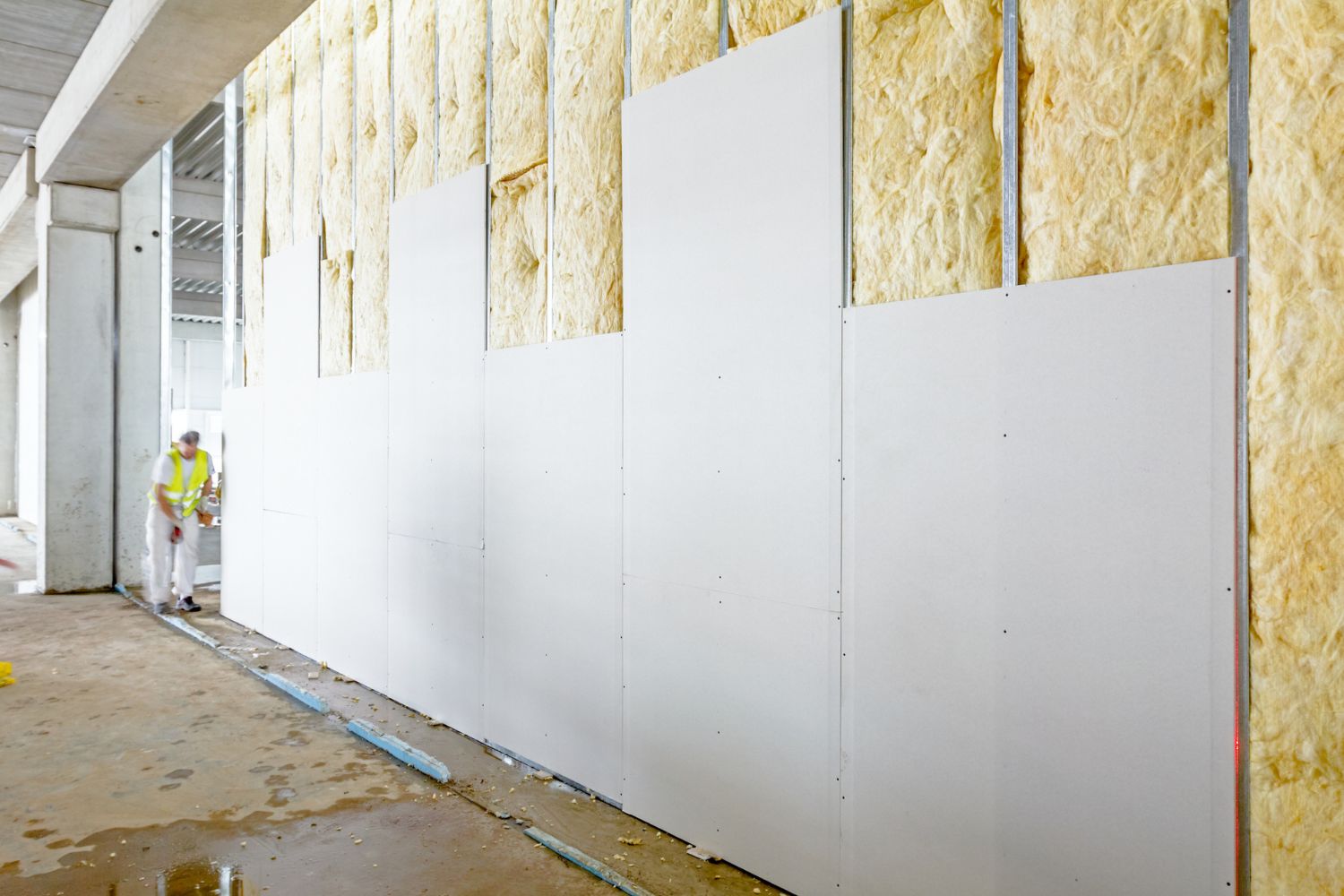
Benefits of Choosing Sheetrock
Homeowners have other options besides sheetrock for their walls, such as plaster and wood paneling. But there’s a lot to love about drywall, including the following benefits.
Affordability
Compared to other construction materials, sheetrock has relatively low production costs. Savings are passed on to consumers, making it a budget-friendly choice for homeowners taking on a new build, repair, or renovation.
By choosing sheetrock, homeowners can stretch their resources and invest in other important components of their home improvement projects, such as finishes, fixtures, or furniture. Other wall and ceiling materials can quickly eat up a set budget, leaving homeowners to pull funds from elsewhere or extend the job’s timeline.
Sheetrock’s affordable pricing is a major benefit, allowing homeowners to get the most value while maintaining financial flexibility for other wants and needs of their home improvement projects.
Durability
Sheetrock is quite durable and can stand up to everyday wear and tear better than other wall and ceiling construction materials. Homeowners who choose a less durable option may experience aesthetic and functional issues, especially if they have children, pets, or tight corners with high-traffic areas in their home.
Cracks, dents, or holes can take away from the visual design of a room while making it more likely that a wall or ceiling will need to be replaced sooner than intended to prevent structural issues. Sheetrock is resistant to cracking and can withstand moderate impacts without denting. It also remains stable over time, maintaining its structural integrity and appearance.
Fire, Mold, and Mildew Resistance
One of the most significant benefits of sheetrock is its fire, mold, and mildew resistance. Without these features, walls or ceilings could pose unnecessary health and safety risks.
For example, walls not made of sheetrock may absorb enough moisture to develop mold and mildew, types of fungi that can cause allergies, respiratory problems, and damage to a home’s structural integrity. There are also unpleasant odors and unsightly stains to worry about. However, sheetrock is made of gypsum, which is inherently resistant to mold growth.
Additionally, walls that lack fire resistance can allow flames to spread more rapidly, endangering lives and property. Sheetrock contains special materials that slow down a moving fire, giving people and pets additional time to reach safety during a disaster. Sheetrock makes a home safer for its inhabitants.
Customization Options
Some construction materials are limited in customization options and can clash with a room’s other components, but sheetrock panels are versatile and adaptable, making them ideal for interior design.
To start, sheetrock can be left smooth or include a pattern or texture. Homeowners can choose modern, rustic, or traditional finishes to match their home’s current style.
Sheetrock can also be easily painted in nearly any color or finish, and it can accommodate various trim types, crown molding, and baseboards as well. Finally, sheetrock panels can easily be cut and shaped for shelving, recessed lighting, or other built-ins.
Homeowners benefit from customizable materials like sheetrock, as it allows them to personalize their living spaces and meet their unique preferences.
Quick Installation
Sheetrock is quick to install, which can benefit homeowners and contractors alike. The material comes in oversize panels, as large as 4 feet by 12 feet. With fewer panels needed to cover a wall or ceiling, installation tends to be less time-consuming than it is with smaller building materials.
Sheetrock panels are also lightweight, making them easier to move around a job site than heavier sheetrock alternatives. The installation process is simple and fast to execute, while using joint sheetrock compound results in less time spent waiting for materials to dry.
Fast installation times reduce costs and project timelines, letting homeowners enjoy their newly finished spaces sooner than later.
Easy Repairs
No wall or ceiling is indestructible, and repairs are sometimes needed to keep a space looking its best and maintain structural integrity. Compared to plaster and other materials, sheetrock is easy to repair, including repairs to both small dents and large holes.
Patching sheetrock is simple and easy to DIY. Joint compound is simply applied to the affected areas, then sanded smooth once dry, and repainted as needed.
For larger blemishes, the affected sheetrock panels can be replaced. This is still a benefit, as replacing only the damaged portion is cost-effective and eco-friendly.
Overall, sheetrock offers homeowners a simple way to keep their interiors looking pristine without having to pay expensive wall and ceiling repair costs or deal with the stress of over-the-top maintenance routines.
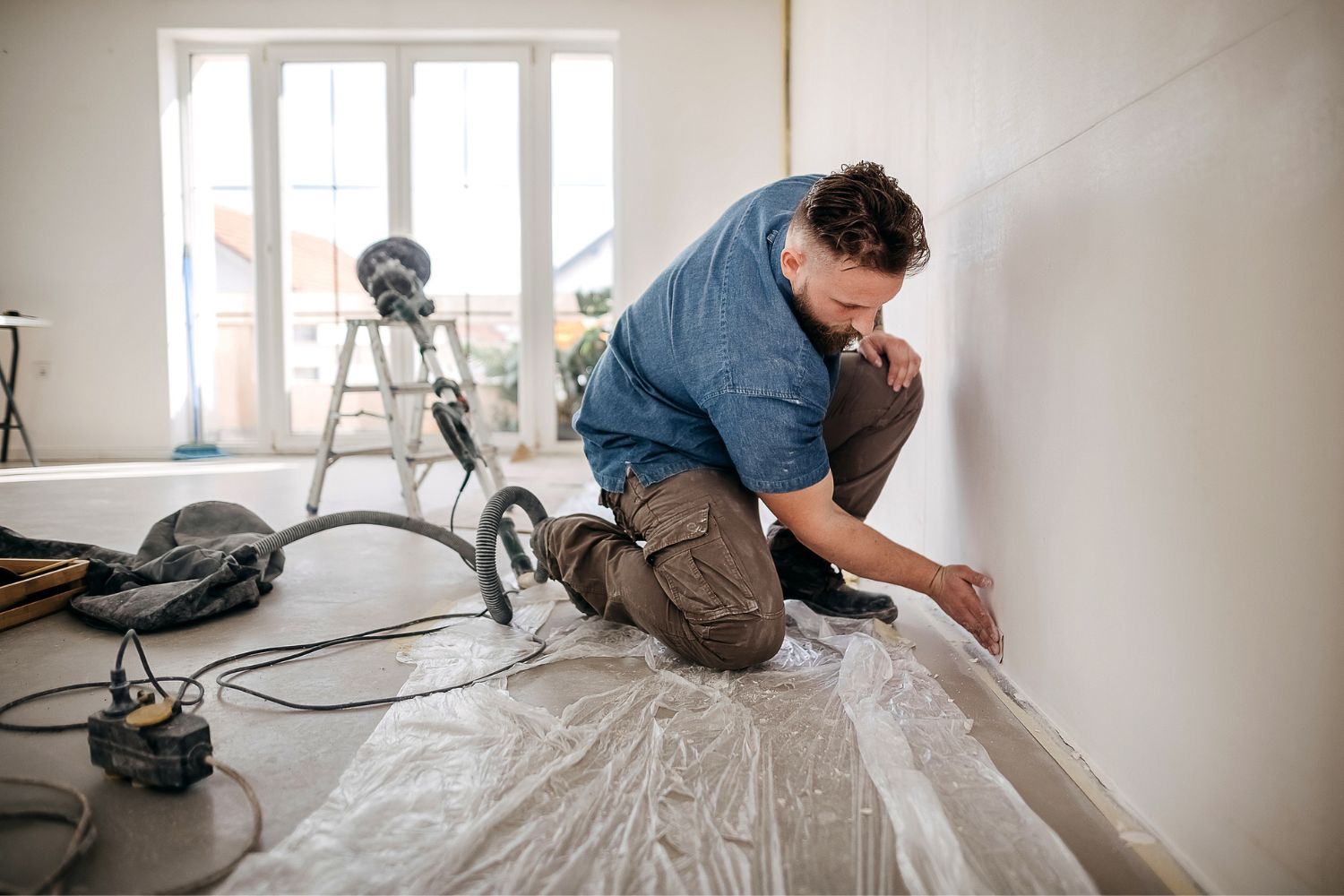
Sheetrock Installation: DIY vs. Hiring a Professional
Hanging and finishing sheetrock panels can be a cost-effective DIY project for homeowners with some construction experience. The basic installation process involves accurately measuring and cutting panels to fit the space, attaching them to studs with screws, and covering the seams and edges with joint compound. Once the compound is dry, a bit of sanding is necessary before any priming, painting, and finishing touches are done.
DIY sheetrock installation costs between $0.30 and $0.50 per square foot and can save homeowners up to $100 per hour on labor costs. Potential additional costs, including tools and joint compound, might outweigh any initial labor savings, though.
For example, joint compound can cost up to $20, screws can add up to $40, and painter’s tape can run another $10. Equipment costs may include renting a drywall lift, tacking on about $50 a day in fees.
Drywall installation mistakes can be costly, so precision in measuring and cutting is crucial. Homeowners who are unsure of their skills or concerned about the potential costs of materials and equipment will want to consider hiring a professional drywall contractor to minimize risks. Working with a professional offers several advantages, such as the following.
- Drywall contractors have years of experience and training, ensuring a high-quality and precise installation.
- Professionals also work efficiently, completing drywall installation jobs quickly.
- Contractors have all the specialized tools and equipment required for the job.
- A professional installation is likely to have a smoother and more polished finish than a DIY installation.
- Drywall contractors are well versed in local building codes and can ensure all necessary requirements are met.
While saving money on a DIY sheetrock installation is possible, hiring a professional can ensure a flawless finish and a better experience.
How to Save Money on Sheetrock Cost
Sheetrock costs can add up quickly, especially when an entire house is undergoing a complete drywall replacement. One way to save on installation is to DIY simple, small drywall projects, but there are other ways to save when hiring out for the job.
- Buy in bulk. Buying sheetrock in larger quantities can be less expensive with a volume discount.
- Get multiple quotes. Request quotes from at least three different installers to find the best deal.
- Opt for standard sizes. Standard-size sheets minimize custom-cutting expenses.
- Consider thinner sheets. Thinner sheetrock can be more affordable but may not be suitable for certain areas.
- Shop sales and promotions. Hunt for sales, discounts, or special offers from local sheetrock suppliers and big-box stores.
- Repair instead of replace. When possible, repair damaged areas of drywall rather than replacing the entire section.
- Simplify layouts. Keep room layouts simple and efficient when designing to minimize waste and reduce the need for extra cutting.
Questions to Ask About Sheetrock Installation
Asking a professional the right questions about sheetrock costs can minimize hiccups in the installation timeline and ensure a positive result. Below are some questions homeowners will want to consider asking when researching sheetrock installation companies and contractors.
- Are you experienced with sheetrock installation?
- How long have you been installing drywall professionally?
- Are you licensed and insured for this type of work?
- Can you provide a list of references?
- Do you have a portfolio of past work?
- What is your typical process for preparing and hanging drywall?
- Do I need to move any furniture or wall decor before the installation?
- How long will the job take from start to finish?
- Will you hang the sheets vertically or horizontally?
- How do you finish seams and corners?
- Do you offer textured sheetrock finishes?
- What does your cleanup process look like?
- Do you offer a guarantee on your work?
- Who will be my main point of contact?
- Do you offer financing?
FAQs
When it comes to home improvement, sheetrock transforms spaces both practically and aesthetically. The average sheetrock cost varies depending on each panel’s type, thickness, and size. While DIY installations can save homeowners money on labor, hiring a professional drywall contractor ensures peace of mind and quality. The following FAQs may offer additional insight for those still wondering if sheetrock is the best option for their remodel or build.
Q. Is drywall cheaper than plaster?
Yes, drywall is cheaper than plaster. While plaster can be the better option for curved walls, it’s rarely the more cost-effective material. For plastered walls, anticipate paying around $500 per 100 square feet. Conversely, the cost to install 100 feet of drywall typically ranges from $100 to $300, plus any applicable drywall removal fees.
Q. Is there a difference between sheetrock and drywall?
Yes, there is a difference between sheetrock and drywall. Although homeowners and contractors alike use these terms interchangeably, they have different meanings. While drywall is the general term for the building material in question, Sheetrock is a brand name of drywall produced by the United States Gypsum Corporation (USG), which invented the first modern drywall product in 1916.
Q. What is sheetrock made of?
Sheetrock is made from gypsum, a naturally occurring mineral composed of calcium sulfate dihydrate. The material is crushed into a fine powder, heated until dehydrated, and then mixed with water and additives like mica, clay, and resin to create a slurry. The slurry is fed between two layers of paper sheets, dried, and cut into sheetrock panels.
Q. Which type of drywall should I choose?
For most home products, standard drywall panels will work just fine. But there are some situations where specialized drywall should be used. For example, laundry rooms and other areas where moisture can be an issue may benefit more from green board drywall than from standard. As another example, soundproof drywall panels may be the better choice in rooms where noise coming in or going out is a concern. It all depends on the unique situation of the space.
Q. Is drywall dust toxic?
According to the Centers for Disease Control and Prevention, drywall joint compounds can release dust that, when inhaled, may cause persistent throat and airway irritation, coughing, phlegm production, and breathing difficulties similar to those with asthma. However, most homeowners have minimal exposure to drywall dust, reducing their overall risk of developing symptoms.
Q. Does it matter if you drywall ceilings or walls first?
Yes, it’s recommended to drywall the ceilings before the walls. Going in this order makes it easier to create tight, fitted corners that reduce the need for repairs as time goes on. Additionally, the walls play a role in supporting the ceiling during the panel installation. Working from the top down can also speed up the entire installation process.
Sources: Angi, HomeAdvisor, Forbes
